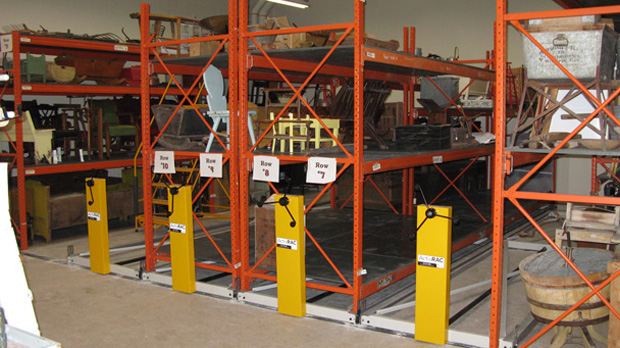Village News
50 Years of Collecting

The Mennonite Heritage Village celebrates its 50th anniversary next year, and anniversaries like this often give staff and volunteers, including the board of directors, of an institution a reason to pause and think. Are we doing what we set out to do? Has our reason for existence changed over the decades?
We have nearly 16,000 artifacts in our collection, ranging from fire engines to thimbles. Some pieces are rare and valuable antiques, others are fragments of everyday items recovered from an archaeological site. As we prepare for a major exhibit featuring the results of 50 years of collecting artifacts for Mennonite Heritage Village, I too take a moment now and then to think about what it all means. Why collect all this stuff?
It was really John C. Reimer who had the idea of collecting for a museum, all the way back in the 1950s. In fact our little Reimer Store (1884) was his first attempt at a museum, where he carefully displayed items he collected over the years. Later, when the Mennonite Village Museum (now Mennonite Heritage Village) was incorporated in 1964, he became the first curator. I still see his influence, and his writings, in our records.
I think Mr. Reimer collected because he saw a world that was changing very quickly. Born in 1899 in Steinbach, he witnessed the introduction of the automobile, women receiving the vote, the Spanish Flu pandemic of 1918, the Depression, the impacts of both World Wars, and the politics of the Cold War. On a very personal level, he would also have seen a Mennonite way of life in Manitoba change from rural to increasingly urban, and a “modern” lifestyle embraced by Mennonites all over the continent. So along with all the growth and change he witnessed, he also experienced what was being lost: the stories and memory of rural, Mennonite village life.
This I believe informed the early collecting activities of the museum from the 1950s until the 1980s. We were to represent the simple, agricultural, first generation of Mennonites arriving in Manitoba in the 1870s. So we have a very good collection of agricultural implements, religious literature, early clothing, tools and cooking items. This is also why we have a windmill, a reconstruction of the 1877 mill that graced downtown Steinbach. Speaking of Steinbach, the businesses and activities which led to this thriving and successful city are represented by collections such as those found in our Print Shop and General Store.
Eventually it was obvious that on some level the museum also needed to acknowledge the impact of thousands of Mennonite immigrants from Russia that had come in the 1920s and early 1950s. Our collections from these people are now nearly overwhelming: they came with so little, but kept so much. And what they kept was very meaningful because it was a reminder of a life to which they could never return.
As time moves on and as generations change, the questions we ask of history also change. Our questions today are not necessarily, “Do you remember this, Grandma?” but perhaps more like, “What motivated these people? What were they thinking and feeling?” As we become more remote from the time period we also become more remote from our ancestors’ daily reality. Our recent archaeological excavations at Blumenhof, and the hundreds of tiny artifacts they have uncovered, tell us about this daily reality in a way that a single family heirloom never could.
Change still feels like it’s happening quickly, just as it must have felt for John C. Reimer. The objects that survive over the years, that somehow against all the odds become part of our collection, help to make this change meaningful. Instead of chaos, we look for stories that order our collective lives. Objects help tell these stories.




